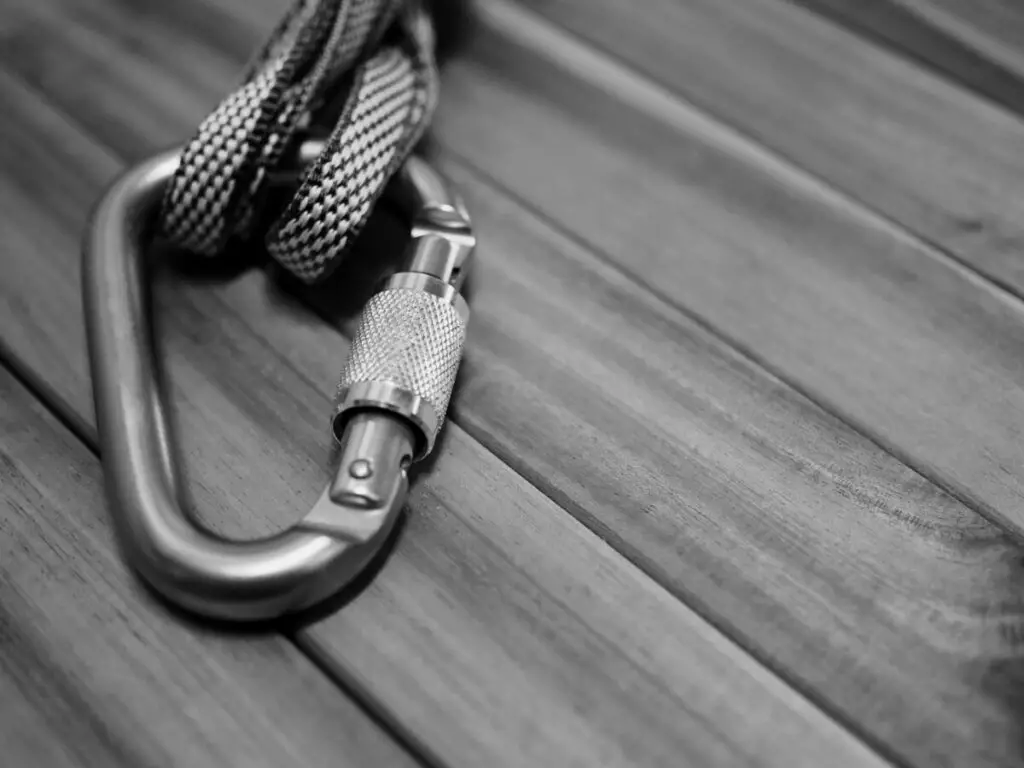
When a sport involves climbing up a rock face with only a rope to catch you if you fall, you probably wonder whether or not there is a weight limit. Is it possible to be too heavy for rock climbing?
There is no weight limit for rock climbing. Many climbing ropes can support a weight of 2,500 pounds or more, and a belayer doesn’t need to weigh more than the climber. However, rock climbing is more difficult for heavier climbers, and many auto-belay systems have a maximum recommended weight.
Weight does still have an effect on rock climbing, whether it’s on the belayer or auto-belay system, the rope, or on your own limitations.
Indoor Weight Limit
Indoor rock climbing facilities don’t typically have a maximum weight limit for rock climbing. Looking at the policies of three different rock climbing facilities in different states–iRock Utah, Hangar 18 Indoor Climbing Gyms, and the River Rock–we can see what kind of weight-related policies that rock climbing facilities often have for their customers.
Most rock climbing facilities don’t have a weight limit. Most of the regulations are centered around age: climbers have to be over a certain age and minors need a parent to sign the waiver. Weight is often not even mentioned in the policies and rules of many facilities.
The only weight limitations in the facility policies are for the auto-belay machines. Auto belays have upper weight limits of around 250 lbs. Otherwise, the rock climbing facilities don’t have any weight limits for climbers.
One thing to note is that rock climbing facilities will often provide harnesses and tend to have between one and three sizes for harnesses. These harnesses can be tightened and loosened to fit people of different sizes. However, harnesses may have a size limit. Larger climbers may have a hard time fitting into a harness, so you may need to purchase a larger one to bring yourself. You may want to call ahead to find out.
If you have cause for concern, try looking on the rock climbing facility website or calling to find out their policies on weight. Some facilities may have a maximum weight because of the particular equipment that they provide. Make sure that you know the policies of the rock climbing facility. If a certain facility has a weight limit that you surpass, try to find another facility. There are a lot of rock climbing facilities out there, most of which don’t have a maximum weight requirement.
Outdoor Weight Limit
There is no weight limit for outdoor rock climbing either. The rock climbing anchors that are inserted into the rock are designed to withstand 3,300 pounds of outward force and 5,600 pounds of downward force. An outdoor climb with good, solid anchors will be able to hold you easily no matter how much you weigh.
Rock climbing equipment can vary a lot depending on the manufacturer. However, equipment certified by the International Climbing and Mountaineering Federation (UIAA) has been tested based on weight support, slippage, and elongation. UIAA certified ropes will be able to hold even heavy climbers. Even a used rope can hold 2205 pounds (1,000 kg). New ropes may be able to hold up to 5,500 pounds (2,500 kg), which is more than a car weighs. Even with the added force that a fall is going to add to your body weight, a climbing rope will be able to hold you.
When you go outdoor rock climbing, it’s important that you purchase good, quality equipment no matter what weight you are. You don’t want the rope to break and for you to fall to the ground, which might be quite far away. Look for equipment that is UIAA certified. Check the maximum weight of the rope and decide whether it can withstand the force of your body weight and any force of a fall.
When outdoor rock climbing, you’re in charge of your own equipment much of the time, so you’re going to need to be responsible for your own safety by using equipment that will support your weight. If you’re worried that a rope won’t be able to support your weight, go with your gut and don’t use it; better safe than sorry.
Belayer Weight Ratio

The best belayer situations involve a belayer and a climber that are similar in weight. This makes it easier for the two to support one another and both can take turns as the climber and the belayer. However, a belayer can be lighter or heavier than the climber and still be able to belay them safely.
When the belayer is heavier than the climber, any falls will be stopped more quickly, which may cause injury; the climber will fall toward the wall, injuring the part of the body that hits the wall (typically the ankles). A heavier belayer needs to be attentive and careful, providing the climber with a soft fall through dynamics.
The belayer can also weigh less than the climber. It just comes with a different share of problems that need to be adjusted for. A climber with a lighter belayer will fall farther because it will take longer for the belay to stop their fall. The belayer can also be carried forward or upward, and the climber may go into an uncontrolled fall. However, a belayer that is lighter than the climber can use an OHM device, which adds friction to the rope and can control a fall when a belayer can’t. Some indoor rock climbing facilities provide these devices for all belayers to use.
So, you don’t need to spend time finding a belayer that has a weight that is equal to or higher than yours. The weight disparity should not be unreasonable, but if the weight difference is very large, the belayer can use an OHM device to help. Finding a belayer is not as difficult as it may seem for a heavier climber because they can still have a lighter belayer.
If your belayer is more than 11 pounds larger or smaller than you, they should be experienced in climbing and belaying so that they can use the proper techniques to belay you safely. It is much more complicated to belay when there is a weight difference, so it is important that the belayer knows what they are doing.
Auto-Belay Weight Limits
When there are weight limits for rock climbing facilities, they mostly have to do with the auto-belay devices. These are machines that are designed to do the work of belaying instead of having another person do it. The ropes of an auto belay attach to the harness. As you climb, the auto belay gathers up slack in the rope, which coils around inside the machine. If you fall, an auto belay will use either magnets or centrifugal force to lower you to the ground slowly and safely.
Most auto-belay systems have a maximum weight of around 265 pounds (120 kg). A heavier climber may alter the way that the machine lowers them, potentially malfunctioning and causing injury or damage to the device. Rock climbing facilities will try to keep those over a certain weight off the auto belays to protect person and machine.
Auto belays also have a minimum weight requirement. This tends to be around 22 pounds or 10 kilograms. A lighter climber will have trouble with an auto belay because their weight may not be able to put enough force on the rope to start pulling it down. The device will not be able to lower them properly, and the climber may be injured.
In most climbing facilities, the auto belay is not the only option, so a heavy climber can still go there and climb. If you weigh more than the auto-belay max weight, you just won’t be able to use the device and will need to have a person belay you instead.
Does Weighing More Make it Harder to Rock Climb?

While there is no maximum weight for rock climbers, a heavier rock climber will probably have a harder time rock climbing than a lighter one. After all, a light rock climber is going to have less weight that they need to carry up the wall with them.
Despite what many people believe, you don’t actually have to be able to hold your entire body weight on your arms. When rock climbing you don’t really use your arms to pull yourself up. Proper rock climbing technique involves pushing yourself up with your legs while using your arms to steady yourself. Your legs are stronger than your arms, and they carry the weight of your body every day, so you will have a much easier time pushing your body weight up the climb with your legs rather than pulling it with your arms.
However, a heavier climber still has more weight to pull, which means that they will tire more quickly. It also means that they have more weight pulling them backward, which means they have to work that much harder to keep from falling backward. If you are a heavier climber, you may want to start climbing on a wall that is slanted a little away from you so that you can support yourself on the wall a little bit. At the very least, don’t start with a wall that is slanted toward you, as it will be much harder.
Heavier climbers are also more susceptible to tendon and muscle strains and injuries to those areas. Heavier climbers should stretch those areas before a climb. You also need to keep an eye on your limits and make sure that you don’t push yourself too hard. You don’t want to end up with a serious injury while you’re out in the middle of nowhere and hanging on a wall. Keep yourself safe and make sure that you don’t cause an injury.
Though size does not always indicate fitness level, heavier climbers tend to be less fit than lighter ones. Climbers with a lower fitness level are going to have a harder time climbing than those who are more athletic. Climbers that are fit and have a lot of practice will have more muscle and better endurance.
Rock climbing is not impossible for a heavier climber, but it can be difficult. It may take more time for you to become better at rock climbing than it will for someone else. Rock climbing when you are very overweight may be impractical or even dangerous. It’s most important that you know your limits and don’t try to overexert yourself.
Does Rock Climbing Help Overweight Climbers?
Rock climbing is an intense type of exercise, so it is going to be healthy and can help climbers to lose weight. Climbing is strength-based, but also has a lot of cardio and can build up endurance. Regularly, rock climbing is a fun and healthy way to lose weight if done regularly. It can also help you become more muscular, improve your endurance, and strengthen your joints.
If you decide to rock climb to lose weight, make sure to start out slow. You don’t want to injure or overexert yourself. Rock climbing is difficult, and you won’t be good at it at first. Don’t push yourself too hard. You also need to put in regular time and effort to get better. It is difficult, but rock climbing is very healthy and you can become really good at it.
In conclusion, rock climbing does not have a maximum weight, though auto belay devices do. Heavier climbers do need to be careful to not hurt themselves and to make sure that they are using the right equipment. No matter what weight you are, you will need a belayer that is either close to your weight or a trained expert with the right equipment. It is going to be harder for a heavier climber to rock climb than a light one, but rock climbing can be very beneficial for a heavier climber, especially after persistent time and effort toward becoming a good rock climber.

